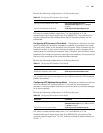330 CHAPTER 11: SYSTEM MANAGEMENT
NMS and the agent running on the network devices. On the network monitor or
detector, RMON agent tracks and accounts for different traffic information on the
segment connected to its port. For example, the total number of packets on a
segment in a certain period of time or that of the correct packets sent to a host.
RMON helps the SNMP monitor the remote network device more actively and
effectively, which provides a highly efficient means for monitoring subnet
operations. RMON can reduce communication traffic between the NMS and the
agent, thus facilitating an effective management over large interconnected
networks.
RMON allows multiple monitors. It can collect data in two ways.
1 The first way is with a special RMON probe. NMS directly obtains the management
information from the RMON probe and controls the network resource. In this way,
it obtains all the information of RMON MIB.
2 The second way is to implant the RMON Agent directly into the network devices,
such as routers, switches, hubs, and so on, so that the devices become network
facilities with RMON probe functions. RMON NMS uses the basic SNMP
commands to exchange data information with the SNMP Agent and to collect NM
information. However, not all the data of the RMON MIB can be obtained with this
method, depending on resources. In most cases, only four groups of information
can be collected. The four groups are: trap information, event information, history
information and statistics information.
The Switch 8800 implements RMON using the second method. With the
RMON-supported SNMP agent running on the network monitor, NMS can obtain
such information as the overall traffic of the segment connected to the managed
network device port, the error statistics and performance statistics, thereby
implementing the management (usually remote) over the network.
Configuring RMON RMON configuration includes tasks described in the following sections:
■ Adding and Deleting an Entry to or from the Alarm Table
■ Adding and Deleting an Entry to or from the Event Table
■ Adding and Deleting an Entry to or from the History Control Table
■ Adding and Deleting an Entry to or from the Extended RMON Alarm Table
■ Adding and Deleting an Entry to or from the Statistics Table
■ Displaying the RMON Configuration
Adding and Deleting an Entry to or from the Alarm Table
RMON alarm management can monitor the specified alarm variables, such as,
statistics on a port. When a value of the monitored data exceeds the defined
threshold, an alarm event will be generated. Generally, the event will be recorded
in the device log table and a Trap message will be sent to NMS. The events are
defined in event management. The alarm management includes browsing, adding
and deleting alarm entries.
Use the following commands to add or delete an entry to or from the alarm table.


















